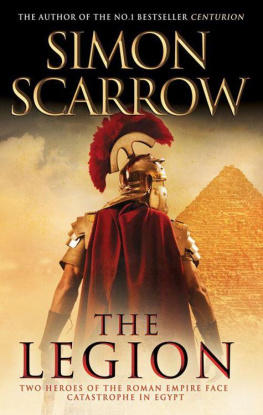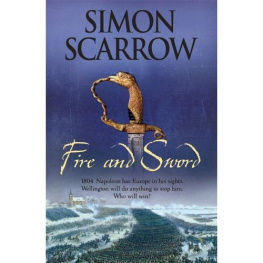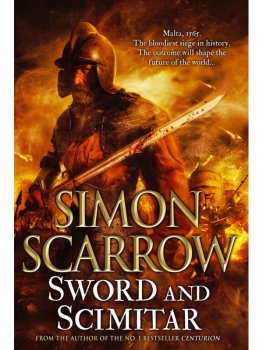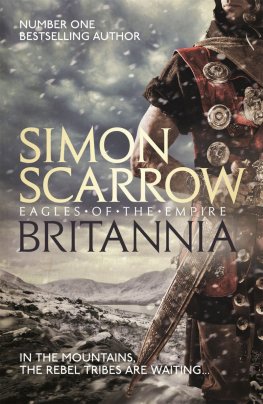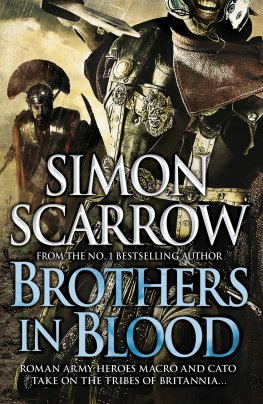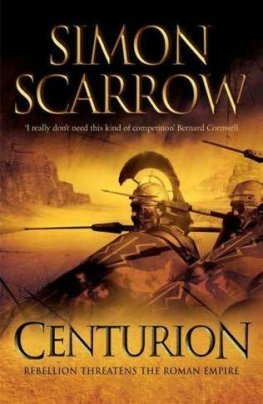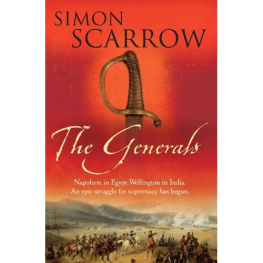The Legion
SIMON SCARROW
headline
www.headline.co.uk
Copyright 2010 Simon Scarrow
The right of Simon Scarrow to be identified as the Author of the Work has been asserted by him in accordance with the Copyright, Designs and Patents Act 1988.
Apart from any use permitted under UK copyright law, this publication may only be reproduced, stored, or transmitted, in any form, or by any means, with prior permission in writing of the publishers or, in the case of reprographic production, in accordance with the terms of licences issued by the Copyright Licensing Agency.
First published as an Ebook by Headline Publishing Group in 2010
All characters in this publication - other than the obvious historical characters - are fictitious and any resemblance to real persons, living or dead, is purely coincidental.
Cataloguing in Publication Data is available from the British Library
eISBN : 978 0 7553 5720 8
This Ebook produced by Jouve Digitalisation des Informations
HEADLINE PUBLISHING GROUP
An Hachette UK Company
338 Euston Road
London NW1 3BH
www.headline.co.uk
www.hachette.co.uk
Table of Contents
By Simon Scarrow
The Roman Series
Under the Eagle
The Eagles Conquest
When the Eagle Hunts
The Eagle and the Wolves
The Eagles Prey
The Eagles Prophecy
The Eagle In The Sand
Centurion
The Gladiator
The Legion
The Wellington and Napoleon Quartet
Young Bloods
The Generals
Fire and Sword
The Fields of Death
To Ahmed (the leader of the Angels) and Mustafa (the Chosen One)
As ever, I am grateful to my wife, Carolyn, for checking over the script as I worked through the novel, and for putting up with me while I was thoroughly lost in the book. Thanks also to my father, Tony, for casting another set of eyes over the final draft. Much of the background detail was gleaned from various research trips to Egypt and down the Nile. My thanks to Ahmed and Mustafa for sharing their knowledge of their fascinating country. There are few nations with such a rich and ancient heritage and they are rightly proud of Egypt.
The Organisation of a Roman Legion
The Twenty-Second Legion comprised some five and a half thousand men. The basic unit was the century of eighty men commanded by a centurion with an optio acting as second in command. The century was divided into eight-man sections which shared a room together in barracks and a tent when on campaign. Six centuries made up a cohort, and ten cohorts made up a legion, with the first cohort being double-size. Each legion was accompanied by a cavalry unit of one hundred and twenty men, divided into four squadrons, who served as scouts and messengers. In descending order the main ranks were as follows:
The legate was a man from an equestrian rather than a senatorial background, as was the case with legions outside Egypt. The legate would command the legion for several years and hope to make something of a name for himself in order to enhance his subsequent political career.
The camp prefect was a veteran who would previously have been the chief centurion of the legion and was at the summit of a professional soldiers career.
Six tribunes served as staff officers. These would be men in their early twenties serving in the army for the first time to gain administrative experience before taking up junior posts in civil administration. The senior tribune was different. He was destined for high political office and eventual command of a legion.
Sixty centurions provided the disciplinary and training backbone of the legion. They were hand-picked for their command qualities. The most senior centurion commanded the First Century of the First Cohort.
The four decurions of the legion commanded the cavalry squadrons and hoped for promotion to the command of auxiliary cavalry units.
Each centurion was assisted by an optio who would act as an orderly, with minor command duties. Optios would be waiting for a vacancy in the centurionate.
Below the optios were the legionaries , men who had signed on for twenty-five years. In theory, a man had to be a Roman citizen to qualify for enlistment, but recruits were increasingly drawn from local populations and given Roman citizenship on joining the legions.
Lower in status than the legionaries were the men of the auxiliary cohorts . These were recruited from the provinces and provided the Roman Empire with its cavalry, light infantry and other specialist skills. Roman citizenship was awarded on completion of twenty-five years of service.
The Imperial Roman Navy
The Romans came to naval warfare rather late in the day and it was not until the reign of Augustus (27 BC14 AD) that they established a standing navy. The main strength was divided into two fleets, based at Misenum and Ravenna, with smaller fleets based in Alexandria and other large ports around the Mediterranean. As well as keeping the peace at sea, the navy was tasked with patrolling the great rivers of the Empire such as the Rhine, the Danube and, of course, the Nile.
Each fleet was commanded by a prefect . Previous naval experience was not a requirement and the post was largely administrative in nature.
Below the rank of prefect the huge influence of Greek naval practice on the imperial fleets is evident. The squadron commanders were called navarchs and commanded ten ships. Navarchs, like the centurions of the legions, were the senior officers on permanent tenure. If they wished, they could apply for transfer into the legions at the rank of centurion. The senior navarch in the fleet was known as the Navarchus Princeps , who functioned like the senior centurion of a legion, offering technical advice to the prefect when required.
The ships were commanded by trierarchs . Like the navarchs, they were promoted from the ranks and were responsible for the running of individual ships. However, their role did not correspond to that of a modern sea captain. They were in charge of the sailing of the ship but, in battle, the senior figure was actually the officer in charge of the ships complement of marines.
As far as the ships go, the most common class of vessel was the small patrol galley, usually termed a liburnian. These were propelled by oars or sails and had a small complement of marines. In the same class was the bireme, somewhat larger and more capable of holding its own in battle. The larger warships, the triremes, quadrimes and quinquiremes, were something of a rarity by the age in which this book is set, relics of a bygone age of naval warfare.
CHAPTER ONE
T he commander of the naval supply station at Epichos was having his morning meal when the optio in charge of the dawn watch made his report. A light drizzle - the first rain in months - had been falling since first light and the optios cloak was covered with droplets that looked like tiny beads of glass.
What is it, Septimus? Trierarch Philipus asked tersely, dipping a hunk of bread into a small bowl of garum sauce in front of him. It was his custom to walk his rounds of the small fort and then return to his quarters to have his breakfast, without interruption.




